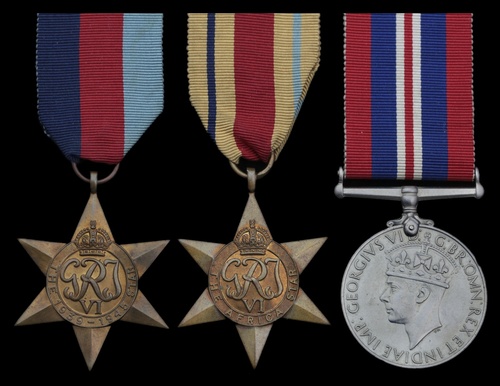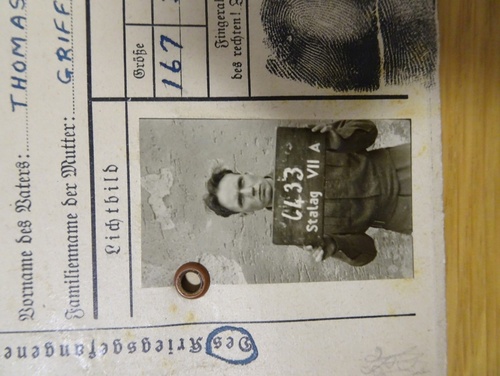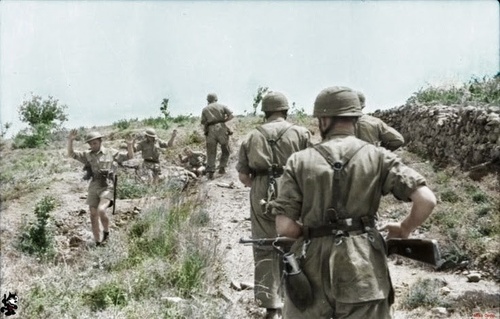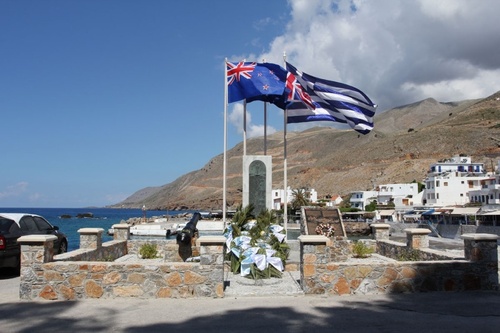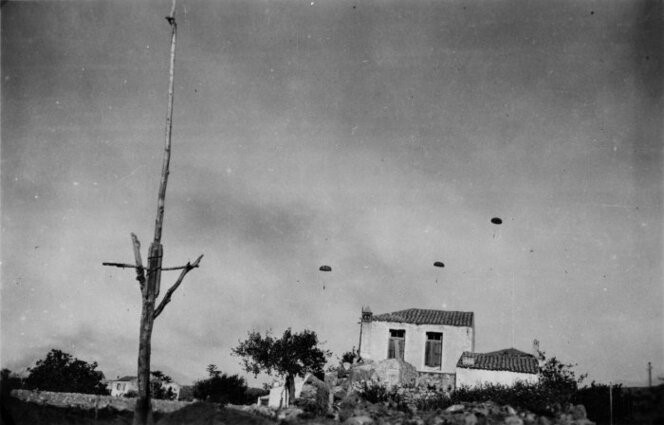Auction: 22002 - Orders, Decorations and Medals
Lot: 104
'Their ammunition finished, they fixed bayonets, but eventually surrounded and heavily outnumbered, they were compelled to surrender. When asked by a German interpreter if he did not think it was time to give in and admit defeat, Sergeant J. Dunne [of the 1st Welch] replied that Britain was never defeated. He was offered a safe conduct if he would take a white flag to his Commanding Officer and ask him to surrender the battalion in the name of humanity, to which he retorted that if he did any such thing his C.O. would shoot him on the spot … The German then informed Sergeant Dunne that the Hood had been sunk, to which he retorted that so had the Bismarck. Finally, the interpreter, who had lived for some years in England, became very friendly and took Sergeant Dunne, who was wounded, to the nearest German hospital … '
A rare example of German clemency - and a classic example of a defiant soldier of the 1st Welch - in the battle for Crete in May 1941; The History of the Welch Regiment 1919-1951, refers.
A well-documented Second World War campaign group of three awarded to Private S. W. Morgan, 1st Battalion, The Welch Regiment, who was taken P.O.W. at the fall of Crete on 1 June 1941
His battalion met a cruel fate, mistakenly being sent forward from Canea with exposed flanks: subsequently surrounded by enemy mountain troops and the much-vaunted Fallschirmjager of Heidrich's 3rd Parachute Regiment, the defiant Welch took heavy casualties
Some of them managed to break out and undertake a punishing 40-mile mountainous trek to Sfakia, where a final stand wase enacted on the high ground overlooking the harbour: out of a starting strength of 21 officers and 830 other ranks, barely 170 men from the Welch eventually reached the safety of Alexandria
1939-45 Star; Africa Star; War Medal 1939-45, in named card box of issue addressed to 'Mr. S. Morgan, Troed Bryn, New Road, Neath, Glam.', extremely fine (3)
Stanley William Morgan was born at Neath Abbey, Glamorgan on 14 December 1919 and attested for the Welch Regiment at Cardiff on 16 March 1940, direct from his occupation as a barber.
Having then served with the 1st Battalion in Egypt in the period leading up to February 1941, he joined the ill-fated Crete garrison. As part of General Freyberg's 'Force Reserve', the Welch occupied positions around Canea (or Chania), in addition to undertaking coastal defence work.
Events following the German airborne invasion on 20 May 1941 need little explanation here, a combination of poor communications and a complex chain of command leading to the island's surrender a little over a week later. Nonetheless, the much-vaunted Fallschirmjager took heavy casualties, a situation only resolved by the capture of Maleme airfield, which enabled the rapid deployment of enemy reinforcements.
1st Welch
On arrival at Crete in February 1941, the Battalion occupied 'Monastery Camp' at Heraklion but, in late March, it moved to new positions in and around Canea, including the village of Galatos.
During May, in a 10-day period leading up to the German airborne invasion on the 20th, and as the Luftwaffe stepped up its operational agenda, the Battalion's positions faced incessant daily attacks from Stukas, on one occasion suffering a loss of 25 killed.
However, on the 21st, the Welch responded in kind, shooting down four gliders and dispatching the paratroopers who emerged from two others. In addition, a fighting patrol captured 25 Fallschirmjager who had taken over a nearby monastery. However, enemy snipers were hard at work too, so much so that 'B' Company was reduced to a strength of just 20 men.
Notwithstanding such losses, the Battalion's carrier section undertook a heroic feat of arms on the 22nd, working in liaison with a detachment of Royal Marines in an attack on enemy held gun sites. But a day or two later further heavy casualties were inflicted on 'A' Company in an ambush on the 24th.
It was about this time that 'individual courage and determination reached unprecedented heights', for as the regimental history of the Welch adds,
'The strain was terrific. Constant bombardment, constant noise and the necessity for the highest degree of personal alertness and courage placed an almost unbearable strain on our troops, who had been fighting without respite for so long. Casualties to both men and to material had been heavy, but morale remained high and our troops hit back with all and every weapon which could bear and with as much as much determination as they had shown in the opening hours of the invasion.'
Such qualities were much in demand on the 27th, when, fatally, as part of Freyberg's 'Force Reserve', the Battalion was ordered to advance to the front of Canea, where, with exposed flanks, it never stood a chance.
Anthony Beevor's definitive history, Crete - the Battle and the Resistance, takes up the story:
'… Soon after dawn on 27 May, Force Reserve heard firing well to their rear on the road to Suda. The implication was plain.
To their front were ranged Ramcke's paratroopers still following the coast and the 100th Mountain Regiment advancing over the Galetas-Daratsos hills. The majority of the German mortars and light artillery were concentrated on them. Heidrich's 3rd Parachute Regiment, although down to battalion strength, was at last able to advance out of Prison Valley and encircle them from the south, and the firing on the Canea-Suda road to their rear had come from the advance of the 141st Mountain Regiment.
When the German attack began at 8 a.m. with a heavy mortar bombardment, Force Reserve was already cut off. Part of it managed to fight a desperate rearguard action on the neck to Akrotiri, but most of it was trapped in front of Canea, with even the Welch Regiment's commanding officer, Colonel Duncan, manning a Bren gun. The bitter resistance continued in pockets until the afternoon, in one case until the next morning. Seven officers and about two hundred and fifty men managed to fight through in small parties to rejoin the main force to the east: one group charged a road block in a lorry.
This sorry blunder had thrown away nearly a thousand of the fittest troops left. Perhaps the tragedy of the Force Reserve was to have had its moment of action preserved until this futile hour, and not to have been sent into the counter-attack five days earlier … '
Morgan's official date of capture is listed as 1 June 1941, so he may have been among those who undertook the 40-mile mountainous trek to Sfakia in the east. If so, he was almost certainly among a force of 100 of the Welch, under Major J. T. Gibson, who fought to the last on the high ground overlooking the harbour.
From the Battalion's original strength at the beginning of the battle of 21 officers and 830 other ranks, barely 170 of them made it back to Alexandria.
Following his capture, Morgan was interned at Stalag VII A, near Munich, from July 1941 to August 1942, at Stalag VIII B - later 344 - at Lamsdorf, from October 1942 to January 1945 and at Stalag VI B at Muhlberg from March 1945 until his liberation. His P.O.W. debrief notes he suffered 'frozen feet' at Muhlberg, owing to not having any boots.
Morgan returned to Wales on his release and died at Neath in September 1998.
Postscript
Today, many memorials and monuments stand as testament to the courage displayed by Allied troops in the battle of Crete. The assistance lent them by the gallant Cretans, who would endure their subsequent occupation under the jackboot with a capital 'R' for resistance, came at huge cost, too.
Numerous German atrocities were committed during the battle and afterwards, a case in point being the murder of around 20 inhabitants of Sfakia, where Morgan likely fought his last action and from whence some 15,000 Allied soldiers were plucked to safety by the Royal Navy; far worse atrocities would be committed during the occupation.
Yet it is at Galatos, near Canea, that the actions of the 1st Welch are formally commemorated on a dedicated memorial, that being the site of the Battalion's original positions as the airborne invasion unfolded.
Sold with the recipient's original Soldier's Service and Pay Book (No. 3961422); a Neath Abbey Comforts Fund booklet listing 'Private S. Morgan' as a prisoner of war and addressed to Stan Morgan; four P.O.W. postcards home to his mother from Lamsdorf; Record of Service and two British Military Authority monetary notes, one for the sum of one shilling and another for two shillings and sixpence.
Recommended reading:
Crete - the Battle and the Resistance, by Anthony Beevor.
The History of the Welch Regiment 1919-1951, by Captain J. de Courcy and Major-General C. E. N. Lomax, C.B., C.B.E., D.S.O.
A Personal Memoir of Word War II, by Henry Brady, a member of 1st Welch at the fall of Crete; copy included.
Subject to 20% VAT on Buyer’s Premium. For more information please view Terms and Conditions for Buyers.
Sold for
£380
Starting price
£220

